Original author: Delphi Digital
Chapter 1: What are Ordinals and BRC-20
introduction
2023 is one of the most transformative years in Bitcoin history. Before that, Bitcoin was known as a stagnant network, but with the advent of Inscription, Bitcoin entered an exciting technological revolution.
The first thing I want to talk about is Ordinals. The development of this new technology has led to a new market, and people quickly accepted and embraced Ordinals. Through emerging Bitcoin token standards such as digital collections, meta-protocols and BRC-20, a vibrant ecosystem is growing rapidly, and its market value has exceeded US$1.8 billion.
The once rigid Bitcoin network is now a thing of the past, filled with many exciting new elements. But what exactly are inscriptions, and what is their value proposition? How do Ordinals and BRC-20 work? Most importantly, how do you involve yourself?
Chapter 2: A closer look
Technical overview
Satoshis
Before we delve into Ordinals, we need to understand its foundation: the Satoshis.
Satoshis, often abbreviated as Sats, are the smallest denomination of BTC. One BTC is equivalent to 100 million Sats, and vice versa, 100 million Sats constitute one BTC. The name comes from Satoshi Nakamoto, the anonymous creator of Bitcoin. The maximum supply hard cap of BTC is 21 million, so the maximum supply hard cap of Sats is 2.1 trillion Sats.
What is the purpose of Stats?
Sats are the native currency of the Bitcoin network. They are therefore used to pay transaction fees and, due to their small denominations, allow for small payments.
Not all Sats are the same!
During the operation of Bitcoin, there are several recurring events that are generated by key mechanisms hard-coded in Bitcoin technology. These recurring events give us a simple way to classify Satoshis, namely: by its scarcity.
Be in it and reap everything you want in this ecosystem?
Jargon Revealed
One of the most confusing parts of Crypto is the lingo (terminology), it is truly a maze of unfamiliar slang. To eliminate confusion, all crypto-native terms in this article are written in italics and are explained immediately or defined in the glossary at the end of the article.
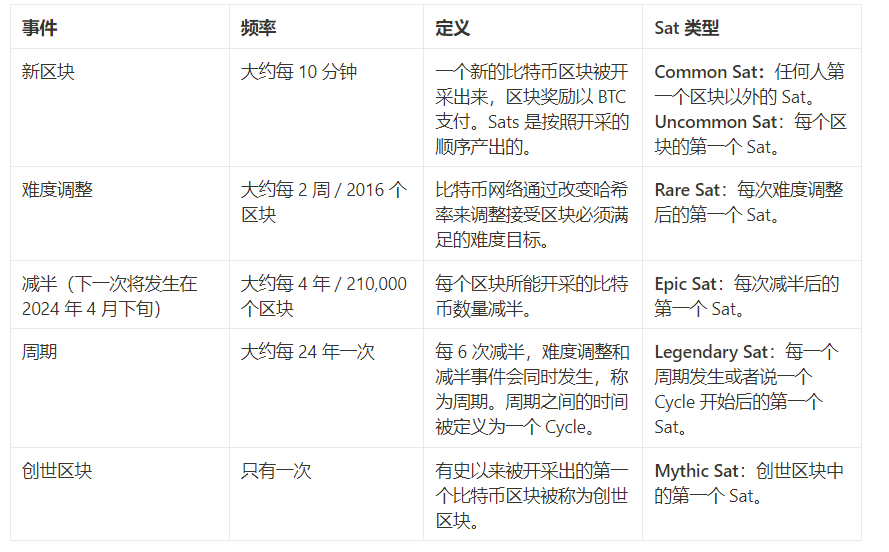
Ordinal Theory: Value Proposition
How do we track rare Sats?
This is where Ordinal Theory, introduced by former Bitcoin Core contributor Casey Rodarmor, comes into play. In a nutshell, Ordinal theory is concerned with giving each Satoshi a unique identifier.
The theory proposes a numbering scheme for Satoshis, assigning each Sat a unique number based on the order in which it was mined. This makes tracking, transferring and collecting Sat a reality, opening up a whole new market for rarity-based trading.
Inscription: Birth of the Ordinals
In 2021, Bitcoin completed a critical upgrade called “Taproot” designed to help the network scale. Casey Rodarmor pioneered a unique way to use some of taproots features to embed data on the Bitcoin blockchain, specifically Satoshis, and inscriptions were born. The inscribed Sat is now commonly called the Ordinal.
The easiest way to understand Ordinal is to imagine someone engraving a work of art on a coin. The owner of the coin can still spend the coin if they wish (to buy a bowl of snail noodles), but the artwork will be engraved on the coin forever. The same goes for Inscriptions, once someone binds data to a single Sat, they can spend that Sat to transfer the data associated with it.
With the emergence of new capabilities to track and identify Sats using Sats theory, the rush to carve arbitrary data into Sats began, and a whole new ecosystem was born.
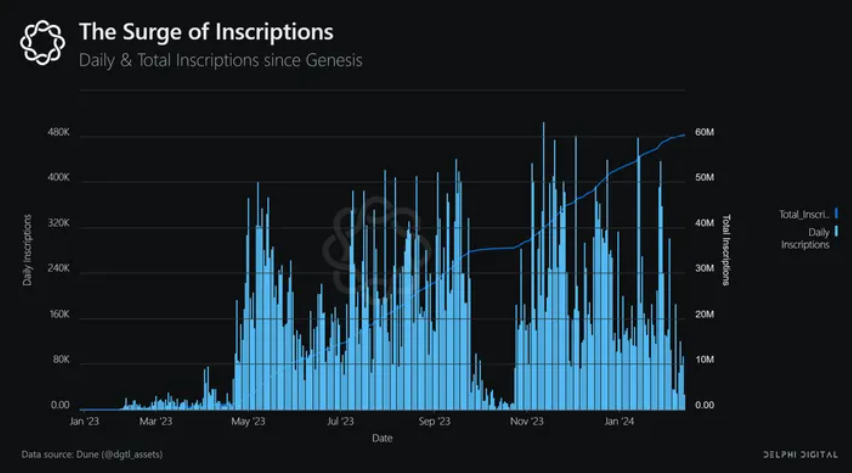
In early February 2023, the total number of inscriptions exceeded 60 million, demonstrating the strong momentum of the vigorous development of this ecology.
Any data burned onto Sats can include images, GIFs, videos, and even HTML code. The only limit to the data is the Bitcoin block size limit (4 MB). It is important to note that each inscription requires a fee, just like any other transaction on the Bitcoin network. The transaction fees paid to burn Sats generally vary based on file size, with larger files being more expensive.
NFTs vs. Ordinals NFTs vs. Ordinals
Ordinals with inscribed images are similar to NFTs on Ethereum. Therefore, people started calling them Bitcoin NFTs. Despite the similarities between the two, there are 4 clear differences between Ordinals and NFTs:
Ordering: Ordinals are engraved on Sats, and Sats are numbered in the order in which they were mined. Therefore, unlike NFT, each Sat has a real order.
Limitations: As mentioned before, when burning inscriptions on Sats, there is a bottleneck, namely, Bitcoin blocks are limited to 4 MB in size, so it limits the amount of data that can be burned on all Sats per block. However, in theory, NFTs based on smart contracts have no obvious data capacity limitations.
On-Chain: Ordinals are stored entirely on-chain, meaning that inscriptions on Sats exist forever on the distributed ledger and are immutable. The metadata of NFT is usually stored on a centralized server, which means that if the server is shut down, the path of the NFT will be lost and cannot point to the correct data source.
Concurrency: Sat can allow multiple different files to be burned. Since inscriptions can be arbitrary data, unique digital products can be created. For example, a Sat can be burned with HTML code pointing to different files on the same Sat, allowing features such as internal hyperlinks to give the embedded Sat similar characteristics to a traditional web page.
Mempool memory pool
Before interacting with applications that support Ordinals, it is important to understand the Bitcoin mempool.
Bitcoin transactions are not added directly to the Bitcoin blockchain. Instead, transactions first go into a queue, called a mempool. All valid transactions will be in this waiting area, then verified and packaged into a block. This process takes about 10 minutes. When the chain is busy, a large number of transactions enter the mempool and miners have difficulty processing them quickly, which leads to congestion and longer transaction times. The direct result is: increased transaction costs.
Bitcoin miners receive transaction fees as a reward for validating and adding transactions to the blockchain. Users can choose the transaction fee for each transaction, which means that in order to encourage miners to prioritize their transactions, users can increase the transaction fee. The higher the fee offered to miners, the greater the incentive and therefore, the higher the priority the transaction will have in the mempool.
Below is a screenshot of the mempool browser.
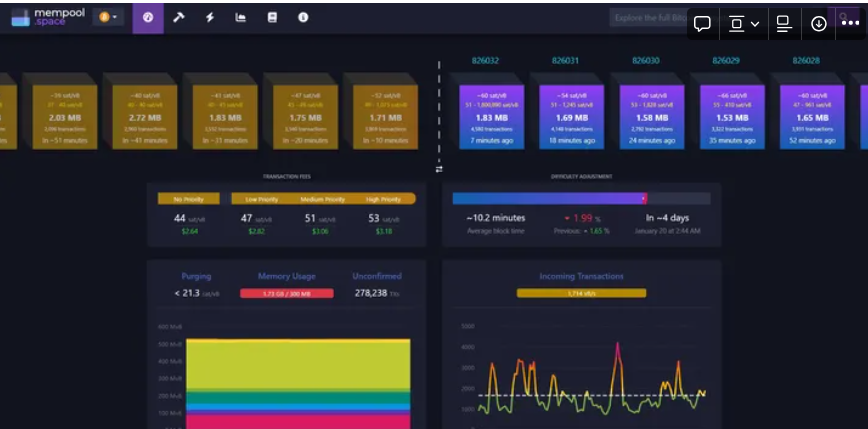
Here you can view several metrics such as current gas cost, block height, and average block time. The Mempool block explorer also projects a visual of the Bitcoin blockchain, with pending blocks in orange and confirmed blocks in a blue-purple gradient. In the top right corner, you can enter any transaction ID or wallet address to get more details, such as the transactions position in the queue or the coins held by a specific address. Overall, mempools are an important tool for tracking transactions when interacting with your application.
BRC-20: The new token standard
Shortly after Ordinals emerged, a Twitter handle called redphone first kicked off a new token standard. Domo put this idea into practice and designed a new token standard: BRC-20. The BRC-20 Inscription quickly gained popularity and began to dominate transactions related to Ordinals.

BRC-20 are Ordinals engraved with JSON data and can create and transmit Tokens. It includes three Token functions: deploy, mint and transfer. Token ownership is proven by the latest transfer receipt, and in practice, wallets and other applications read these transfer receipts and allocate the BRC-20 balance to the address that owns the transfer receipt.
The BRC-20 token contract originally created by Domo is $ORDI. Initially, the minting fee is US$5 per batch of 1,000 ORDI. Recently, $ORDI’s market cap exceeded $1.4 billion, and the token is currently trading at $67.72! This means that if someone minted an original batch of 1,000 ORDI for $5, it would now be worth over $67,000.
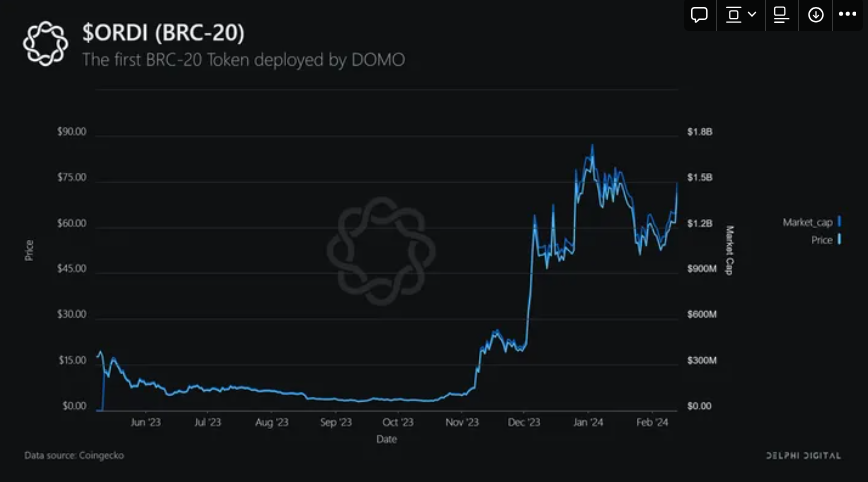
Interested in learning more about the intricacies of the BRC-20 token? Check out these deep dives from Delphi Digital:
BRC-20: past, present and future
The Current State of Bitcoin
Chapter 3: How to get started
This chapter will introduce how to create and use a Bitcoin wallet, as well as the advantages and disadvantages of each wallets interaction with inscriptions. If you are already an expert in this area, please skip this chapter.
How to create a Bitcoin wallet that supports Ordinals
The first task is to create and fund your Bitcoin wallet. A Bitcoin wallet will store your Sats and Ordinals, as well as interact with various applications.
The most important point here is: your wallet must integrate a separate address for Ordinals, or have the ability to freeze burned Sats. As mentioned earlier, Sats are the native currency of the Bitcoin network and are used to pay transaction fees. Ordinals are just *Sats with data burned on them,* which brings with it the risk that you may inadvertently use your precious Ordinal Sats to pay for transaction fees.
Therefore, it is highly recommended to use a wallet that supports two addresses or has the ability to freeze Sats to prevent the loss of inscribed Stas.
There are two decent wallets that support this feature, Unisat and Xverse. Unisat provides better application interoperability, while Xverse is more focused on user experience. The choice is yours! In the following tutorial, we use the Xverse wallet.
Install your Bitcoin wallet
Visit the Xverse web page. Xverse Wallet is available as a mobile app or browser extension. For better interaction with the application in the future, it is recommended to use browser extensions. To install the browser extension, click Download and add the extension to Chrome.
Create your Bitcoin wallet
Once installed, click on the icon under the browser extension and then click on Create Wallet. Each new wallet generates a unique mnemonic phrase, usually consisting of 12 words.
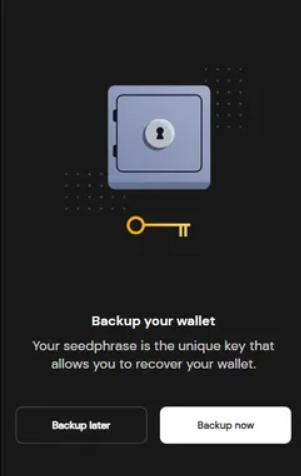

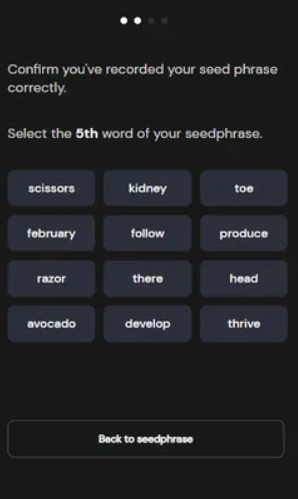
This is your wallet private key. If your wallet is lost, this is the only way to help you recover it, so be sure to keep it safe! Because anyone who gets this mnemonic phrase can completely control your wallet and assets. It is generally recommended that the mnemonic phrase be written down physically (such as in a small notebook) rather than stored electronically (such as in a computer document or mobile phone photo album) to avoid unauthorized access due to damage to the device. .
After backing up your mnemonic phrase, select the correct word to confirm that your mnemonic phrase has been stored.
Finally, create a password. Use it every time you want to access your wallet from a browser extension.
Meet your Bitcoin wallet for the first time


Your wallet displays your token balance and is where you can send, receive, exchange, and buy tokens. In Settings, you can access your mnemonic phrase and change the display currency. Currently, my token balance is all zero.
When clicking Send or Receive, your wallet will display three different Bitcoin addresses, similar to bank account numbers, that must be provided when sending or receiving funds. This is where Xverse’s user-friendliness comes in handy.
The first address is your BTC address and should always be used to fund your wallet. Your BTC is stored here and used to pay transaction fees. Never use this address to manually receive Ordinals or BRC-20 tokens to avoid paying transaction fees in Ordinal Sats.
The second address is only available for Ordinals and BRC-20 tokens. When deploying and minting inscriptions, Xverse automatically ensures that Ordinals and BRC-20 tokens are sent to this address. However, if you are performing a peer-to-peer transaction (receive directly), please make sure to provide this address to receive Ordinals and BRC-20.
The third address is Stacks NFT and SIP-10 tokens, which is beyond the scope of this guide and will not be discussed in detail.
Fund your wallet
You can fund your wallet in a few different ways:
Buy BTC directly from your wallet: Click the Buy button and you can buy BTC directly through third-party service providers such as Moonpay or Transak. These portals allow you to purchase Bitcoin using a debit or credit card. Please note that using third parties introduces additional potential risks.
Send BTC from a centralized exchange: If you use a centralized exchange like Coinbase and Robinhood, you can fund your wallet directly from your exchange account. Even if you dont have an exchange account yet, creating one may help avoid the additional risks that come with using other funding options. When sending BTC, please provide your Bitcoin wallet address (first address). Transactions usually take approximately 10 minutes to confirm.
Cross-chain bridge: If you are a cryptocurrency native and already have a wallet on a network such as Ethereum, you can cross BTC from your existing wallet to your Bitcoin wallet. Please note that this approach may introduce some security risks, counterparty risks, and smart contract risks. Please do your research before using these apps!
If you want to interact with any of the apps listed below, we recommend trying it with a small amount of money until youre completely comfortable with the process.
Chapter 4: Ordinals and BRC-20 Ecological Guidelines
Although the Ordinals ecosystem is still relatively young, there are several applications that support the trading of Ordinals and BRC-20 tokens. Here is a list of some apps worth checking out:
OKX, Unisat and Magic Eden: Ordinals Market
The Ordinal Marketplace facilitates the purchase, sale, and exchange of Ordinal and BRC-20. Through these platforms, you can effortlessly sell your Ordinals and BRC-20s tokens and collect various collectibles. Additionally, these marketplaces often allow users to deploy, mint, and transfer inscriptions.
If size and trading volume are used as criteria, the top three markets are OKX, Unisat and Magic Eden. While OKX is currently leading the race, it limits certain features to only users using native OKX wallets. On the other hand, Unisat and Magic Eden offer a more user-friendly experience.
Quick recommendation
Although you can trade Bitcoin NFTs on these markets, Ordinals Market andOrd.ioCovers a wider range of NFT collections and is a great tool for tracking trending collections over the past 24 hours, 30 days, 90 days, etc.
Ordinals Bot: Deploy, Cast and Transfer Ordinals
One of the easiest ways to create inscriptions and deploy any type of Ordinal is the OrdinalsBot application. Through the integrated API, users can generate inscription orders in batches, which is especially convenient when creating entire collections. Payment for API services can be made using the Lightning Network or directly on Bitcoin.
It supports all types of inscriptions, with additional features including burning to specific Satoshi types, such as burning only on uncommon sats.
Magisat: Rare Sats Market
Magisat is a marketplace dedicated to trading Rare Sats. You can trade, buy and sell Satoshis, covering any rare and strange Satoshis, such as Pizza Satoshis. Pizza Satoshis is a very typical case in the Bitcoin community, related to the pizza incident in 2010 (a programmer bought 2 pizzas with 10,000 BTC, which is claimed to be the first time that BTC can be used as real currency to purchase physical goods).
Additionally, Magisat lets you scan any Sats in your wallet to see its rarity.
Ordinalhub: aggregator and analytics tool for Ordinals
Ordinalhub is an aggregator, a tool that aggregates Ordinals from different markets into one platform and provides features such as trends, recent sales, and bottom price displays. It simplifies transactions by helping users find the best prices, as typically BRC 20 tokens and collectibles are priced differently on different platforms.
Liquidium: Ordinals lending platform
Liquidium is one of the first Ordinals applications to support decentralized finance, or DeFi. The protocol allows peer-to-peer lending of Bitcoin using Ordinals inscriptions as collateral.
Currently, the first tier of the lending market includes NodeMonkes, Bitcoin Frogs and RSIC.
Alex Go: Leading DeFi
AlexGos total transaction volume has exceeded US$800 million and TVL is US$122 million, making it one of the leading protocols for DeFi on Stacks on Bitcoin L2. It provides support for Ordinals through four applications:
AMM DEX: A native decentralized exchange using automated market maker AMM to facilitate transactions between various Bitcoin ecological assets.
B 20 : A native trading application that supports trading BRC-20 tokens using the order book.
Kickstart: Launchpad for various projects, including Ordinals and BRC-20.
Connect: Asset bridge supporting Bitcoin, BRC-20 and EVM compatible networks.
Chapter 5: Ecological Development Highlights
recursive inscription
One of the earliest groundbreaking developments in the field of inscription was the introduction of recursion. Recursive inscriptions first attracted attention in June 2023, and the total number of recursive inscriptions has recently exceeded 350,000.
In a nutshell, recursive inscriptions allow new inscriptions to call and reference data from existing inscriptions. This may sound boring, but the implications are profound!
First, recursion provides a practical way to circumvent the 4 MB limit of Bitcoin blocks. By splitting the data into multiple inscriptions in different blocks that reference each other, we can easily upload large files to the Bitcoin network. Two other significant benefits of recursion are improved storage efficiency and reduced transaction costs.
Most importantly, recursion is the origin of a large number of developer tools. Through recursion, code bases can be built with inscriptions. As a result, Ordinals truly reaches the next level of optimization. For example, we can now use recursion to create high-quality NFT collections on Bitcoin. Because it is recursive, it allows creators to leverage existing inscription libraries to aggregate the collections inscription traits to simplify the creation of thousands of unique NFTs. creation process without having to individually create thousands of NFT sets as before.
Alternative Token Standard
BRC-20 tokens have only three functions (deployment, minting, and transfer), which are not only limited in functionality, but also static in development. As a result, new experimental token standards emerged one after another, determined to become an improved version of BRC-20. Here’s a quick look at two current alternatives:
The CRBC-20 token standard called Cybord takes advantage of the fact that inscriptions can directly store arbitrary data. As a result, the cost of inscription is significantly reduced and the indexing process is greatly simplified, making CRBC-20 a cheaper and faster alternative to BRC-20.
Like CRBC-20, ORC-20 addresses the limitations of BRC-20 and focuses on enhanced safety and flexibility. Unlike BRC-20, ORC-20 supports a wider range of data formats, allows transaction reversal, and is backwards compatible with BRC-20. Additionally, ORC-20 saves transaction fees by running reusable inscriptions at lower costs.
Chapter 6: The Road Ahead
Key takeaways
In early 2023, Bitcoin experienced major developments centered on Inscriptions, creating immutable digital assets: Ordinals and BRC-20 s tokens. Although emerging Ordinal is not yet mature enough, its market capitalization now exceeds$1.7 billion, and there is no doubt that it drove the innovation of Bitcoin by allowing users to store all kinds of data on Sat.
The ecosystem currently includes centralized and decentralized exchanges, markets, popular token standards, and protocols based on its technology. Because it is in the early stages, speculation and enthusiasm among Ordinals supporters have increased with the emergence of new token standards, and even DeFi applications have begun to try to financialize Ordinals.
Additionally, the recent approval of a spot Bitcoin ETF marks a milestone in institutional adoption. Although the long-term effects are controversial, Ordinals and the BRC-20 ecosystem are expected to benefit from Bitcoins widespread adoption and growing demand.
future outlook
Although the ecosystem is booming, doubts have never stopped, and some groups of Bitcoin enthusiasts advocate that developers eliminate Ordinal technology and related elements. Although this criticism is multi-faceted, it stems from the shortcomings of the technology itself and its impact on the Bitcoin network, so they even consider inscriptions as system vulnerabilities.
Detailing this discussion is beyond the scope of this guide. However, it is important to acknowledge that Ordinals and BRC-20 transactions have led to an explosion in demand for Bitcoin block space, which may have a negative impact on Bitcoin’s network health. Unreasonably high transaction fees and long confirmation times due to a crowded mempool are just one of the negative consequences. On the other hand, inscriptions are an important source of revenue for miners securing the network. The upcoming Bitcoin halving, which will occur around late April 2024 when miners’ block rewards are cut in half, will further shake up this debate.
Although the future of Ordinals and BRC-20 may still be an uncertain factor, the development surrounding their ecology is still feverish. Hopefully this guide not only piques your interest, but also encourages you to further explore the world of Bitcoin Ordinals. To keep you curious and point you toward potential avenues to study it, here are two upcoming trends worth keeping an eye on:
Trac Network: Pioneer of decentralized indexing
For Ordinals to work properly, an Ordinals index is required. Without getting into technical complexities, it’s critical to understand that Ordinal and BRC-20 transactions are done via off-chain indexing of on-chain data, allowing the entire network to identify, track, and sort Ordinals, which means indexing is critical infrastructure.
To exchange inscriptions between two parties, both entities must be running the same index. Currently, the vast majority of projects are using the ord indexer to resolve compatibility issues, making this important infrastructure very centralized. Reliance on a single indexer poses serious technical risks, so some protocols are working to build viable competitors. One of them is Trac Network.
The core product of Trac Network is Trac Core, and its value proposition is: a decentralized open source indexer. It achieves the goal of decentralization by introducing the governance token $TRAC. This means that $TRAC holders are able to influence the direction and manage the development of Trac Core by voting on key development projects.
$TRAC is currently trading at $4.65 and has a market cap of $97m, however so far, this decentralized indexer has not been fully launched.
For more information, check out“Many Words On Trac Network”。
Rune: Fungible Token Protocol
Casey Rodarmor, the creator of Ordinal Theory, is developing a fungible token protocol with an expected release date of April. This new fungible Bitcoin token protocol, called Rune, is based on the Ordinals technology stack and aims to solve many of the problems with the current BRC-20 token standard. For example, tokens created using the Rune protocol will not require off-chain infrastructure, eliminating many of the points of contention against BRC-20.
Since it was built by the same person who came up with Ordinal Theory, speculation about the official Ordinal token issuance is rife in the community. Such a token standard could have real potential to replace BRC-20.
Aaron is herehereThat wraps up Casey Rodarmors latest podcast on Rune, a gold mine of alpha.
Glossary
Aggregator: Aggregator integrates products, activities, data, information, etc. on various markets and exchanges and brings them together on one platform. By using aggregators, users can efficiently determine the best price.
Automated Market Makers (AMMs): AMM is an algorithm that promotes decentralized trading of digital assets. In a nutshell, AMMs automatically exchange assets by using liquidity pools (smart contracts containing two or more cryptocurrencies).
Bitcoin Halving: Bitcoin Halving is a key mechanism built into the core design of Bitcoin. Approximately every four years, block rewards are halved to control Bitcoin’s supply, scarcity, and inflation. Miners secure the network by solving complex mathematical equations and are incentivized through block rewards to verify and maintain the state of the Bitcoin network. After each halving, miners’ rewards are cut in half.
BRC-20: BRC-20 is a token standard whose purpose is to generate and manage fungible tokens in the Bitcoin blockchain. It uses the Ordinals protocol for data engraving and is a type of Ordinal.
Bridging Bridges: Bridges in crypto are applications that allow users to exchange assets between two different networks. Bridging, therefore, refers to the transfer of assets across networks.
Decentralized Finance (DeFi): Decentralized finance refers to applications that use blockchain technology to provide financial services without the need for middlemen. DeFi allows you to trade assets, earn interest, borrow money, and more without the need for a third-party middleman.
EVM-compatible: EVM refers to the Ethereum Virtual Machine, which is the computing engine of the Ethereum network. It controls the state of the network and enables smart contracts to run. EVM compatibility refers to the ability of a network or protocol to write and deploy code that is compatible with the Ethereum Virtual Machine.
Floor Price: The floor price refers to the lowest market price of an asset, which means the cheapest price at which a commodity can be purchased.
Governance Token: Governance Token is a utility token that grants holders the ability to participate in project decision-making. Voting is often required on governance proposals that impact the projects trajectory.
L2: L2 is the abbreviation of Layer 2, which refers to the network built on layer 1, such as the second layer network of the Bitcoin network. Generally speaking, L2 networks exist to introduce features that enhance and extend the underlying blockchain, such as reducing transaction fees.
Ordinals: Ordinals are specific Sats with arbitrary data engraved on Bitcoin. Data can include text, images, videos, GIFs, audio, and even code.
Satoshis (Sats for short): Satoshis, often abbreviated as Sats, are the smallest denomination of BTC. One BTC is equivalent to 100 million Sats. The name comes from Satoshi Nakamoto, the anonymous creator of Bitcoin. Sats are used to pay transaction fees and enable micropayments. The maximum supply hard cap of Bitcoin is 21 million, so the maximum supply hard cap of Sats is 2.1 trillion sats.
TVL: TVL refers to Total Value Locked and is a commonly used metric in cryptocurrencies to define the total value of digital assets locked in an application.
Special thanks to Redphone and Gutz for their valuable feedback and contributions to this report.



